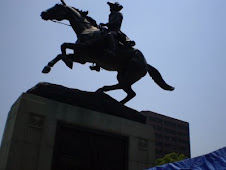And what a birthday party it was!
Airport Security's Grand Illusion
By Anne Applebaum
Wednesday, June 15, 2005; Page A25
If you happen to be reading this while standing in one of those disturbingly slow, zigzag lines at airport security -- looking repeatedly at your watch, wondering if this time you really will miss the plane -- here's something to make you feel worse: Almost none of the agony you are experiencing is making you safer, at least not to any statistically significant or economically rational degree. Certainly any logical analysis of the money that has been spent on the airport security system since Sept. 11, 2001, and the security that the system has created, must lead to that conclusion.
[]
...99.992 percent of intercepted items were nail scissors, cigarette lighters, penknives and the like.
Yet this mass ceremonial sacrifice of toenail clippers on the altar of security comes at an extraordinarily high price. The annual budget of the federal Transportation Security Administration hovers around $5.5 billion -- just about the same price as the entire FBI -- a figure that doesn't include the cost of wasted time. []There has also been a price to pay in waste, since when that much money is rubbed into a problem with that kind of speed -- remember, the TSA had only 13 employees in January 2002 -- a lot of it gets misspent. In the case of the TSA, that waste includes $350,000 for a gym, $500,000 for artwork and silk plants at the agency's new operations center, and $461,000 for its first-birthday party. More to the point, the agency has spent millions, even billions, on technology that is inappropriate or outdated.
In fact, better security didn't have to cost that much. Probably the most significant measure taken in the past four years was one funded not by the government but by the airline industry, which put bulletproof doors on its cockpits at the relatively low price of $300 million to $500 million over 10 years. In extremely blunt terms, that means that while it may still be possible to blow up a plane (and murder 150 people), it is now virtually impossible to drive a plane into an office building (and murder thousands). By even the crudest cost-benefit risk analysis, bulletproof cockpit doors, which nobody notices, have the potential to save far more lives, at a far lower cost per life, than the screeners who open your child's backpack and your grandmother's purse while you stand around in your socks waiting for them to finish.
But, then, this isn't a country that has ever been good at risk analysis. If it were, we would never have invented the TSA at all. Instead, we would have taken that $5.5 billion, doubled the FBI's budget, and set up a questioning system that identifies potentially suspicious passengers, as the Israelis do. Even now, it's not too late to abolish the TSA, create a federal training program for airport screeners, and then let private companies worry about how many people to hire, which technology to buy and how long the tables in front of the X-ray machines should be (that last issue being featured in a recent government report). But every time that suggestion is made in Congress, someone denounces the plan as a "privatization" of our security and a sellout.
Actually, the whole thing is a jobs program. Why do you think unemployment is down?











No comments:
Post a Comment